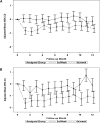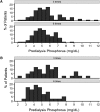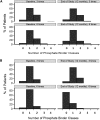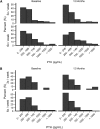Effects of frequent hemodialysis on measures of CKD mineral and bone disorder
- PMID: 22362907
- PMCID: PMC3312501
- DOI: 10.1681/ASN.2011070688
Effects of frequent hemodialysis on measures of CKD mineral and bone disorder
Abstract
More frequent hemodialysis sessions and longer session lengths may offer improved phosphorus control. We analyzed data from the Frequent Hemodialysis Network Daily and Nocturnal Trials to examine the effects of treatment assignment on predialysis serum phosphorus and on prescribed dose of phosphorus binder, expressed relative to calcium carbonate on a weight basis. In the Daily Trial, with prescribed session lengths of 1.5-2.75 hours six times per week, assignment to frequent hemodialysis associated with both a 0.46 mg/dl decrease (95% confidence interval [95% CI], 0.13-0.78 mg/dl) in mean serum phosphorus and a 1.35 g/d reduction (95% CI, 0.20-2.50 g/d) in equivalent phosphorus binder dose at month 12 compared with assignment to conventional hemodialysis. In the Nocturnal Trial, with prescribed session lengths of 6-8 hours six times per week, assignment to frequent hemodialysis associated with a 1.24 mg/dl decrease (95% CI, 0.68-1.79 mg/dl) in mean serum phosphorus compared with assignment to conventional hemodialysis. Among patients assigned to the group receiving six sessions per week, 73% did not require phosphorus binders at month 12 compared with only 8% of patients assigned to sessions three times per week (P<0.001). At month 12, 42% of patients on nocturnal hemodialysis required the addition of phosphorus into the dialysate to prevent hypophosphatemia. Frequent hemodialysis did not have major effects on calcium or parathyroid hormone concentrations in either trial. In conclusion, frequent hemodialysis facilitates control of hyperphosphatemia and extended session lengths could allow more liberal diets and freedom from phosphorus binders.
Figures




Comment in
-
Mineral metabolism outcomes with frequent hemodialysis.Nat Rev Nephrol. 2012 Mar 13;8(5):254. doi: 10.1038/nrneph.2012.56. Nat Rev Nephrol. 2012. PMID: 22410494 No abstract available.
Similar articles
-
Intensive Hemodialysis, Mineral and Bone Disorder, and Phosphate Binder Use.Am J Kidney Dis. 2016 Nov;68(5S1):S24-S32. doi: 10.1053/j.ajkd.2016.05.024. Am J Kidney Dis. 2016. PMID: 27772640 Review.
-
Nocturnal but not short hours quotidian hemodialysis requires an elevated dialysate calcium concentration.J Am Soc Nephrol. 2003 Sep;14(9):2322-8. doi: 10.1097/01.asn.0000083044.42480.c1. J Am Soc Nephrol. 2003. PMID: 12937309
-
[Changes in mineral metabolism in stage 3, 4, and 5 chronic kidney disease (not on dialysis)].Nefrologia. 2008;28 Suppl 3:67-78. Nefrologia. 2008. PMID: 19018742 Spanish.
-
Phosphorus Counting Table for the control of serum phosphorus levels without phosphate binders in hemodialysis patients.Clin Nutr ESPEN. 2019 Aug;32:153-157. doi: 10.1016/j.clnesp.2019.03.008. Epub 2019 Apr 20. Clin Nutr ESPEN. 2019. PMID: 31221281
-
Effectiveness of phosphate binders in adult patients with end stage renal disease receiving hemodialysis: a systematic review.JBI Database System Rev Implement Rep. 2019 Jan;17(1):49-73. doi: 10.11124/JBISRIR-2017-003740. JBI Database System Rev Implement Rep. 2019. PMID: 30204711
Cited by
-
Comparative Effectiveness of Dialysis Modality on Laboratory Parameters of Mineral Metabolism.Am J Nephrol. 2022;53(2-3):157-168. doi: 10.1159/000521508. Epub 2022 Feb 28. Am J Nephrol. 2022. PMID: 35226895 Free PMC article.
-
Mineral metabolism outcomes with frequent hemodialysis.Nat Rev Nephrol. 2012 Mar 13;8(5):254. doi: 10.1038/nrneph.2012.56. Nat Rev Nephrol. 2012. PMID: 22410494 No abstract available.
-
Strategies for Phosphate Control in Patients With CKD.Kidney Int Rep. 2019 Jun 20;4(8):1043-1056. doi: 10.1016/j.ekir.2019.06.002. eCollection 2019 Aug. Kidney Int Rep. 2019. PMID: 31440695 Free PMC article. Review.
-
Improved long-term survival with home hemodialysis compared with institutional hemodialysis and peritoneal dialysis: a matched cohort study.BMC Nephrol. 2019 Feb 13;20(1):52. doi: 10.1186/s12882-019-1245-x. BMC Nephrol. 2019. PMID: 30760251 Free PMC article.
-
Conventional hemodialysis is associated with greater bone loss than nocturnal hemodialysis: a retrospective observational study of a convenience cohort.Can J Kidney Health Dis. 2016 Jun 1;3:27. doi: 10.1186/s40697-016-0118-5. eCollection 2016. Can J Kidney Health Dis. 2016. PMID: 27252880 Free PMC article.
References
-
- Block GA, Klassen PS, Lazarus JM, Ofsthun N, Lowrie EG, Chertow GM: Mineral metabolism, mortality, and morbidity in maintenance hemodialysis. J Am Soc Nephrol 15: 2208–2218, 2004 - PubMed
-
- Hruska KA, Teitelbaum SL: Renal osteodystrophy. N Engl J Med 333: 166–174, 1995 - PubMed
-
- Kidney Disease Improving Global Outcomes (KDIGO) CKD-MBD Work Group: KDIGO clinical practice guideline for the diagnosis, evaluation, prevention, and treatment of Chronic Kidney Disease-Mineral and Bone Disorder (CKD-MBD). Kidney Int Suppl 113: S1–S130, 2009 - PubMed
Publication types
MeSH terms
Substances
LinkOut - more resources
Full Text Sources
Medical

